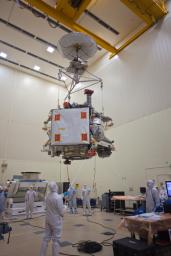
|
Moving Juno to Environmental Testing
- Click the image above for a larger view
- Full-Res JPEG (3744 x 5616) (1.5 MB)
- Full-Res TIFF (3744 x 5616) (63.1 MB)
Caption:
Technicians transfer NASA's Juno spacecraft from its rotation fixture to the base of its shipping container in preparation for a move to environmental testing facilities.
The large white square on the spacecraft is the largest of Juno's six microwave radiometer antennas, masked by a protective covering. The spacecraft's overall size was determined, at least in part, by the dimensions of this antenna, which is the size required in order to observe deep enough into Jupiter's atmosphere to measure its global water abundance. This antenna will sense microwave emissions from Jupiter at a depth of up to 1000 times the pressure on Earth at sea level.
Background Info:
This image was taken on Sept. 27, 2010, in the high-bay cleanroom at Lockheed Martin Space Systems in Denver, during Juno's assembly process.
NASA's Jet Propulsion Laboratory, a division of the California Institute of Technology, Pasadena, manages the Juno mission for the principal investigator, Scott Bolton, of Southwest Research Institute, San Antonio. Lockheed Martin Space Systems is building the spacecraft. The Italian Space Agency, Rome, is contributing an infrared spectrometer instrument and a portion of the radio science experiment.
For more information about Juno visit http://www.nasa.gov/juno .
Cataloging Keywords:
| Name | Value | Additional Values |
|---|---|---|
| Target | Jupiter | |
| System | Jupiter | |
| Target Type | Planet | |
| Mission | Juno | |
| Instrument Host | Juno | |
| Host Type | Orbiter | |
| Instrument | ||
| Detector | ||
| Extra Keywords | Atmosphere, Color, Infrared, Radio, Rotation, Water | |
| Acquisition Date | ||
| Release Date | 2010-12-16 | |
| Date in Caption | ||
| Image Credit | NASA/JPL-Caltech/LMSS | |
| Source | photojournal.jpl.nasa.gov/catalog/PIA13717 | |
| Identifier | PIA13717 | |
